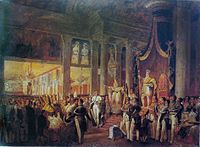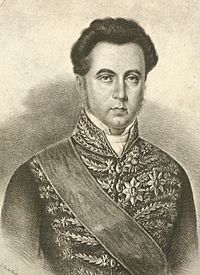History of the Empire of Brazil
[1] On 12 December 1815 Dom João VI, then regent on behalf of his incapacitated mother, Queen Dona Maria I, elevated Brazil from colony to Kingdom united with Portugal.
A few, such as Bonifácio, had further goals which included abolishing the slave trade and slavery itself, instituting land reform, and economic development of the country free of foreign loans.
They opposed the end of slavery, wanted a democracy in which only they were enfranchised, preservation of the existing social hierarchy, a monarch who would be a mere figurehead, and a weak federal organization in which the provinces would be ruled by the local interests without interference from the central government.
[15] Pedro traveled to São Paulo province to secure its loyalty to the Brazilian cause, but he received a letter from Bonifácio as he was returning to Rio de Janeiro on 7 September.
In a moment which would become the most iconic in Brazilian history, he unsheathed his sword and affirmed that "For my blood, my honor, my God, I swear to give Brazil freedom", and then cried out: "Independence or death!
[43][45][46] Once the idea had been aired, the vast majority of the Municipal Chambers, composed of councilmen elected by the Brazilian people as their local representatives, voted in favor of its instant adoption as the Constitution of the Empire.
Unlike the rest of the nation, its population consisted of both Luso-American and Hispano-American elements, a result of colonial times when sovereignty over the region shifted between Portugal and Spain.
"[53] The situation only worsened in 1828 when the war in the south ended with the loss of Cisplatina, which became the independent republic of Uruguay[60] and the usurpation of Maria II's throne by Prince Miguel, Pedro I's younger brother.
[61] Uncapable of dealing with Brazil and Portugal affairs at the same time, the emperor abdicated in behalf of his son (who became Pedro II) on 7 April 1831 and immediately departed for Europe to restore his daughter to her throne.
[63] Joaquim Nabuco, writing in the 1890s, remarked that the Brazilian republicans saw this period as their chance to prove that the country could survive in peace without a monarch as superior arbiter, as a neutral character above rival parties.
[70] Vasconcelos acted not only as a leader but also as a mentor to the younger generation of his faction which included Honório Hermeto Carneiro Leão (later the Marquis of Paraná), Paulino Soares de Sousa (later the first Viscount of Uruguay) and Joaquim José Rodrigues Torres.
[77] The priest Antônio Feijó planned a coup d’état in which he would assume dictatorial powers and the constitutional amendment would be enacted concurrently without the approval of the National Assembly (Parliament).
[86] The exception was the Ragamuffin War, which began as yet another dispute between political factions in the province of Rio Grande do Sul[83] but quickly evolved into a separatist rebellion financed by the Argentine dictator Don Manuel Rosas.
[90] The first hints of what would later become the Conservative Party appeared when they began throwing their support to candidates other than Feijó and it became clearer after Deputy Carneiro Leão initiated talks with the restorationists in October 1834.
"[92] This marked the extinction of the always weak Moderate Party,[93] whose demise was symbolized with the death of Evaristo de Veiga in May, the last tie that kept united both Nativists and the Coimbra bloc.
[97] The Coimbra bloc's credibility was considerably enhanced by "the close links, both political and personal, that its leaders established with the booming coffee sector in the Paraíba valley just to the north of Rio de Janeiro city.
[107] With the decline of the Coimbra bloc also came of Vasconcelos', whose political influence and power over the party was superseded by the next generation, mainly Carneiro Leão, Rodrigues Torres and Paulino de Sousa.
[131][132] The most radical faction of the liberals in the province of Pernambuco, known as the Partido da Praia ("Party of the Beach"), were openly prepared to revolt and retake power by force.
[132] With Brazil internally pacified and the British menace gone, the conservative cabinet could turn its attention to another serious foreign threat, the Argentine dictator Don Juan Manuel de Rosas.
[142] Brazil's cabinet decided to forge alliances with other nations threatened by the dictator's ambitions[143] and sent an army commanded by Luis Alves de Lima e Silva (later the Dukes of Caxias) to Uruguay which crossed the border on 4 September 1851.
[163] The Emperor asked the Marquis (later Duke) of Caxias, who had commanded the Brazilian forces in the Platine War and who was also a member of the Conservative Party, to head a new cabinet on 2 March 1861.
[165] Caxias named men who were part of the pure and moderate Conservatives to the remaining portfolios in an effort to weaken the revigorated Liberal opposition and consolidate a workable governing majority.
It was doomed when José Tomás Nabuco de Araújo Filho, the former Justice minister in the Conciliation cabinet, delivered a speech advocating a merger of moderate Conservatives and Liberals into a truly new political party.
[190] In March 1871, Pedro II named the conservative José Paranhos, Viscount of Rio Branco as the head of a cabinet whose main goal was to pass a law to immediately free all children born to female slaves.
The law "split the conservatives down the middle, one party faction backed the reforms of the Rio Branco cabinet, while the second—known as the escravocratas (English: slavocrats)—were unrelenting in their opposition", forming a new generation of ultraconservatives.
[195] By contrast, this new generation of ultraconservatives had not experienced the Regency and early years of Pedro II's reign, when external and internal dangers had threatened the Empire's very existence; they had only known prosperity, peace and a stable administration.
[208] His increasing "indifference towards the fate of the regime"[209] and his inaction to protect the imperial system once it came under threat have led historians to attribute the "prime, perhaps sole, responsibility" for the dissolution of the monarchy to the emperor himself.
[211] Even though the Constitution allowed female succession to the throne, Brazil was still a very traditional, male-dominated society, and the prevailing view was that only a male monarch would be capable as head of state.
[213] A weary Emperor who no longer cared for the throne, an heir who had no desire to assume the crown, an increasingly discontented ruling class who were dismissive of the Imperial role in national affairs: all these factors presaged the monarchy's impending doom.
While Pedro II was receiving medical treatment in Europe, the parliament passed, and Princess Isabel signed on 13 May 1888, the Golden Law, which completely abolished slavery in Brazil.











